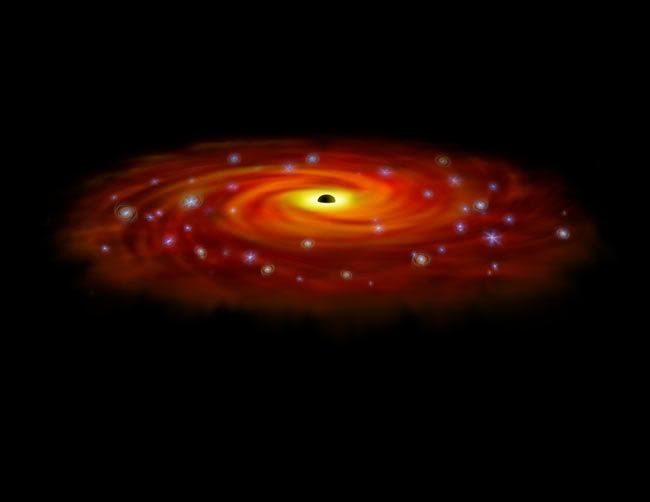Stellar Nursery Near Milky Way's Black Hole
Remember that supermassive black hole at the center of the Milky Way we talked about briefly here? It's in the news!
This is a bit surprising. We're accustomed to thinking of black holes as voracious, destructive monsters, but astronomers have just discovered that a region very close to the black hole is apparently spawning new, massive stars. Space.com has the details. Check out the graphics -- very cool.

Artist's conception of what we think is happening very close to Sgr A* [Ed note: Sgr A* is the name of the Milky Way's central black hole -- it's named for the constellation in which it is found, Sagittarius]. The supermassive black hole is surrounded by a disk of relatively cool gas where massive stars form. Current star formation is represented by small, blue disks.
Then again, this is not so surprising when you think about it. Stars form wherever there are dense pockets of gas. Stars should be able to form as long as you've got two things: 1) enough distance from the event horizon (beyond which even light can't escape the gravitation of the black hole) to avoid gravitational disruptions; and 2) a mechanism for carrying away energy and allowing the gas to cool and condense into stars. Well, the Milky Way's central black hole has a mass of approximately a million solar masses, so its event horizon is a few million kilometers in radius. These massive stars are a bit less than a light-year (~10 trillion kilometers) away from the black hole, so we're okay there. And those big, high-powered, bi-polar jets we talked about before offer a mechanism to transport enough energy out of the gas clouds that the gas can cool and condense into stars.
This has implications for my own research, as it supports the idea that the central supermassive black hole is intimately tied to the formation and evolution of the host galaxy. Nifty!
This is a bit surprising. We're accustomed to thinking of black holes as voracious, destructive monsters, but astronomers have just discovered that a region very close to the black hole is apparently spawning new, massive stars. Space.com has the details. Check out the graphics -- very cool.

Artist's conception of what we think is happening very close to Sgr A* [Ed note: Sgr A* is the name of the Milky Way's central black hole -- it's named for the constellation in which it is found, Sagittarius]. The supermassive black hole is surrounded by a disk of relatively cool gas where massive stars form. Current star formation is represented by small, blue disks.
Then again, this is not so surprising when you think about it. Stars form wherever there are dense pockets of gas. Stars should be able to form as long as you've got two things: 1) enough distance from the event horizon (beyond which even light can't escape the gravitation of the black hole) to avoid gravitational disruptions; and 2) a mechanism for carrying away energy and allowing the gas to cool and condense into stars. Well, the Milky Way's central black hole has a mass of approximately a million solar masses, so its event horizon is a few million kilometers in radius. These massive stars are a bit less than a light-year (~10 trillion kilometers) away from the black hole, so we're okay there. And those big, high-powered, bi-polar jets we talked about before offer a mechanism to transport enough energy out of the gas clouds that the gas can cool and condense into stars.
This has implications for my own research, as it supports the idea that the central supermassive black hole is intimately tied to the formation and evolution of the host galaxy. Nifty!



2 Comments:
Spiral galaxies have a host of mysteries tied to them, as you're undoubtedly aware. Star formation itself presents some problems in hydrodynamics that have yet to be solved beyond dispute. I wouldn't be surprised to learn that black holes are integral to the process.
One of the questions unlikely to be answered any time soon is the quantum evaporation problem. It's supposed to happen -- but how fast? And to what effect gravitationally? Can we cipher it out, or must we merely sit back and watch?
I suppose that's just my American microwave-habituated impatience talking.
Well, you've got me there. I know very little about quantum evaporation.
Post a Comment
Testing ...
<< Home